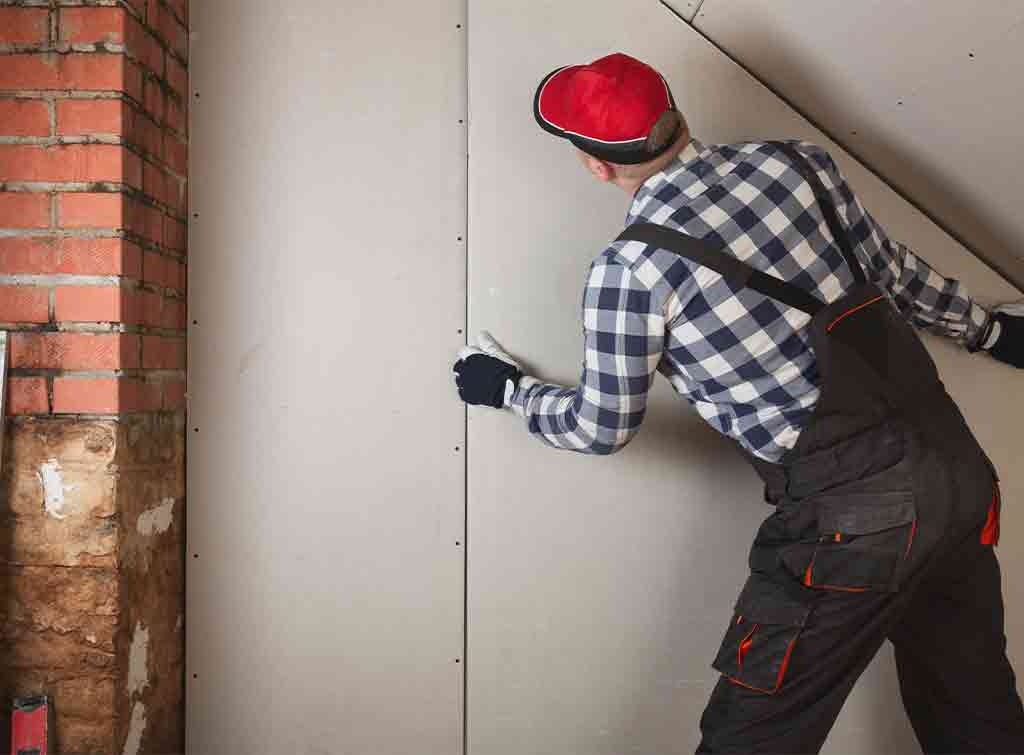Drywall, also known to be gypsumboard or plasterboard, is a suitable interior wall and ceiling material. Drywall is comprised of a base made up of gypsum plaster sandwiched among two layers of paper or fiberglass.
Holes and dents: Drywall can easily be damaged by furniture, doorknobs or even accidental impacts.
Water damage: Dwelling in water may cause the drywall to turn discolored and warped or even moldy.
Setting or shifting the foundation could result in cracks in the walls.
Drywall aging: Drywall may become brittle over time and cracks or holes may form.
You may need to cut holes in the drywall for plumbing or electrical work.
Drywall repair generally involves filling in holes or cracks with joint compound, sanding, and then painting to be in line with the surrounding area. Sometimes, sections of drywall might need to be removed completely in more serious cases. The homeowner should take care to fix any issues with your drywall immediately to avoid further damage and to keep the beauty of your home. Check out the most popular drywall calgary contractors blog for website recommendations including residential drywall contractors, licensed drywall contractors, drywall contractors near me, drywall guys near me, drywall guys, drywall and plastering contractors near me, drywall guys near me, union drywall companies, local drywall repair, drywall experts near me and more.

What Can Happen If Drywall Is Damaged And What Can Be Done To Fix It?
To ensure a smooth finish, there are many steps involved in repairing drywall. The process usually includes framing, insulation soundproofing, patching, tapping mudding, painting, and framing. This is a brief overview of each step. Framing: The framing might need to be repaired if the drywall is damaged from structural issues.
Insulation When the framing is complete, insulation can be added to the wall cavity. This is especially important for walls that are exterior or that divide living areas.
Soundproofing If you want to soundproof your home, an additional layer can be added between framing drywall. This will help to reduce noise transmission between rooms.
Patching: Drywall that has been damaged should be removed once the framing, insulation soundproofing, and soundproofing have been completed. This may require cutting off the damaged area and replacing it with a another piece of drywall.
Taping: To create a seamless surface, it is recommended to tap the joints between the pieces of drywall once they are set. It is necessary to apply joint compound and then tape the joints.
Apply the joint compound after the tape has been applied. It will fill in any holes and smoothen out the surface. You may need multiple coats, each requiring sanding in between.
Painting: After the joint compound is dry, smooth the surface and then paint the walls to match the wall or space. It could take several coats depending on the final finish you want.
Repairing drywall can take a long time. But, with the right technique and attention to details you can get an impressive, professional look.

Tips And Advice To Help You Select The Right Drywall Contractor
It is essential to choose the most suitable drywaller for your project. This will ensure that it is completed on-time, within budget, and at a high-quality standard. Here are some tips and suggestions to select the best drywall company. Request suggestions: Ask your friends, relatives or friends to recommend an expert. The most effective way for contractors to be identified is through word-of-mouth recommendations.
Conduct your research on the internet. You can look up reviews and reviews of a local drywall contractors on Google, Yelp, and other review sites. This can give you an idea about their reputation and quality.
Check credentials: Make sure that the contractor you choose is insured, licensed, and licensed, and bonded. This helps you avoid any accidents or damages that could happen during the construction.
Request estimates: Request written estimates from at minimum three contractors. This will provide greater understanding of the range of costs and also help to identify the red flags.
Ask questions: Do not be afraid to ask questions regarding the contractor's expertise as well as their processes and the materials they use. A good contractor will be willing to answer any questions you might have and explain their method.
Be responsive and communicate well: You want a contractor who is well-informed and is easy to reach. This will ensure that the work goes on schedule and that you are satisfied.
Refer to references: Get references from the contractor and keep in touch with them. This will give you an idea of the contractor's quality work and professionalism.
With these suggestions follow these suggestions, you will be able to locate an experienced drywaller who is trustworthy, knowledgeable and suitable for your project.